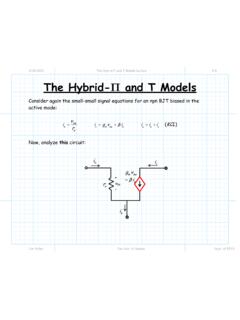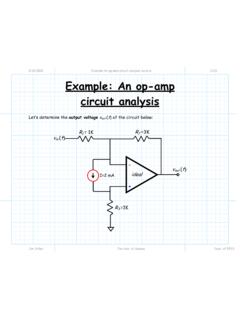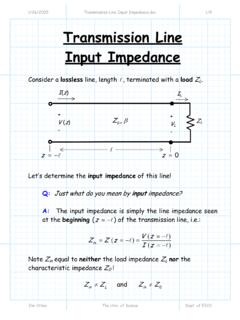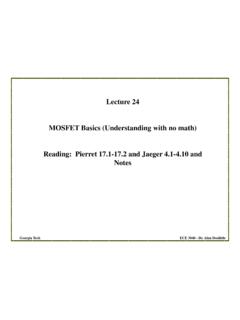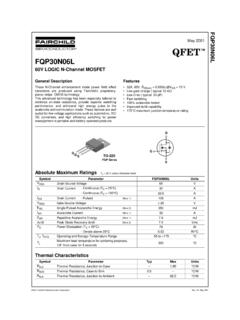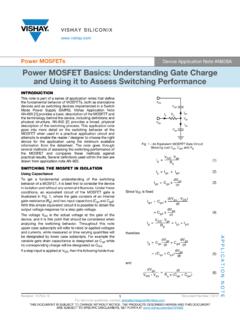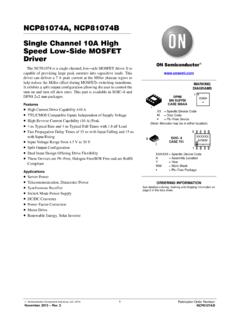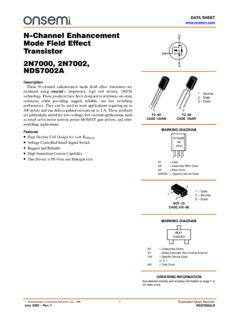Transcription of 4.3 MOSFET Circuits at DC - ITTC
1 10/22/2004 4_3 mosfets Circuits at DC 1/1 Jim Stiles The Univ. of Kansas Dept. of EECS MOSFET Circuits at DC Reading Assignment: pp. 262-270 Example: NMOS Circuit Analysis Example: PMOS Circuit Analysis Example: Another PMOS Circuit Analysis V V 1K 1K : A: HO: Steps for DC Analysis of MOSFET Circuits 10/22/2004 Steps for DC Analysis of MOSFET 1/7 Jim Stiles The Univ. of Kansas Dept. of EECS Steps for Analysis of MOSFET Circuits To analyze MOSFET circuit with sources, we must follow these five steps: 1. ASSUME an operating mode 2. ENFORCE the equality conditions of that mode.
2 3. ANALYZE the circuit with the enforced conditions. 4. CHECK the inequality conditions of the mode for consistency with original assumption. If consistent, the analysis is complete; if inconsistent, go to step 5. 5. MODIFY your original assumption and repeat all steps. Let s specifically look at each step in detail. 1. ASSUME Here we have three choices cutoff, triode, or saturation. You can make an educated guess here, but remember, until you CHECK, it s just a guess! 10/22/2004 Steps for DC Analysis of MOSFET 2/7 Jim Stiles The Univ. of Kansas Dept. of EECS 2. ENFORCE For all three operating regions, we must ENFORCE just one equality.
3 Cutoff Since no channel is induced, we ENFORCE the equality: 0DI= Triode Since the conducting channel is induced but not in pinch-off, we ENFORCE the equality: ()22 GStDDSDSIKV VV V = Saturation Since the conducting channel is induced and is in pinch-off, we ENFORCE the equality: ()2 GStDIKV V= 10/22/2004 Steps for DC Analysis of MOSFET 3/7 Jim Stiles The Univ. of Kansas Dept. of EECS Note for all cases the constant K is: 12 WKkL and Vt is the MOSFET threshold voltage. 3. ANALYZE The task in analysis of a MOSFET circuit is to find one current and two voltages! a) Since the gate current GIis zero (0GI=) for all mosfets in all modes, we need only to find the drain current DI--this current value must be positive (or zero).
4 B) We also need to find two of the three voltages associated with the MOSFET . Typically, these two voltages are GSV and DSV, but given any two voltages, we can find the third using KVL: GSDSDGVVV=+ Some hints for MOSFET DC analysis: 1) Gate current 0GI= always !!! 2) Equations sometimes have two solutions! Choose solution that is consistent with the original ASSUMPTION. 10/22/2004 Steps for DC Analysis of MOSFET 4/7 Jim Stiles The Univ. of Kansas Dept. of EECS 4. CHECK You do not know if your analysis is correct unless you CHECK to see if it is consistent with your original assumption! WARNING!
5 -Failure to CHECK the original assumption will result in a SIGNIFICANT REDUCTION in credit on exams, regardless of the accuracy of the analysis !!! Q: What exactly do we CHECK? A: We ENFORCED the mode equalities, we CHECK the mode inequalities. We must CHECK two separate inequalities after analyzing a MOSFET circuit. Essentially, we check if we have/have not induced a conducting channel, and then we check if we have/have not pinched-off the channel (if it is conducting). Cutoff We must only CHECK to see if the MOSFET has a conducting channel. If not, the MOSFET is indeed in cutoff. We therefore CHECK to see if: (NMOS) (PMOS)GStGStVVVV<> 10/22/2004 Steps for DC Analysis of MOSFET 5/7 Jim Stiles The Univ.
6 Of Kansas Dept. of EECS Triode Here we must first CHECK to see if a channel has been induced, : (NMOS) (PMOS)GStGStVVVV> < Likewise, we must CHECK to see if the channel has reached pinchoff. If not, the MOSFET is indeed in the triode region. We therefore CHECK to see if: (NMOS) (PMOS)DSGStDSGStVVVVVV< > 10/22/2004 Steps for DC Analysis of MOSFET 6/7 Jim Stiles The Univ. of Kansas Dept. of EECS Saturation Here we must first CHECK to see if a channel has been induced, : (NMOS) (PMOS)GStGStVVVV> < Likewise, we must CHECK to see if the channel has reached pinchoff. If it has, the MOSFET is indeed in the saturation region.
7 We therefore CHECK to see if: (NMOS) (PMOS)DSGStDSGStVVVVVV> < 10/22/2004 Steps for DC Analysis of MOSFET 7/7 Jim Stiles The Univ. of Kansas Dept. of EECS If the results of our analysis are consistent with each of these inequalities, then we have made the correct assumption! The numeric results of our analysis are then likewise correct. We can stop working! However, if even one of the results of our analysis is inconsistent with our ASSUMPTION, then we have made the wrong assumption! Time to move to step 5. 5. MODIFY If one or more of the circuit MOSFETSs are not in their ASSUMED mode, we must change our assumptions and start completely over!
8 In general, all of the results of our previous analysis are incorrect, and thus must be completely scraped! 10/22/2004 Example NMOS Circuit 1/4 Jim Stiles The Univ. of Kansas Dept. of EECS Example: NMOS Circuit Analysis Consider this DC MOSFET circuit: Let s ASSUME the NMOS device is in saturation. V V 1K 1K Example NMOS Circuit 2/4 Jim Stiles The Univ. of Kansas Dept. of EECS Thus, we must ENFORCE the condition that: ()2tGSDIKVV= Now we must ANALYZE the circuit. Q: What now? How do we proceed with this analysis? A: It s certainly not clear. Let s write the circuit equations and see what happens.
9 From the Gate-Source loop KVL: (1) = Therefore, rearranging: .50 DGSIV= And from the Drain-Source loop KVL: (1)(1) = Therefore, rearranging: .10 0 2 DSDVI= V V 1K 1K DI10/22/2004 Example NMOS Circuit 3/4 Jim Stiles The Univ. of Kansas Dept. of EECS Look! We can equate the NMOS device equation and G-S equation to find GSV. ()()()22250012 = =+ + A quadratic equation! The solutions to this equation are: Q: Yikes! Two solutions! Which one is correct? A: Note we assumed saturation. If the MOSFET is in saturation, we know that: >= Only one solution of the quadratic satisfies this conidtion, : > Thus, we use 3 solution that is consistent with our original assumption.
10 10/22/2004 Example NMOS Circuit 4/4 Jim Stiles The Univ. of Kansas Dept. of EECS Inserting this voltage into the Gate-Source KVL equation, we find that the drain current is: 5050 = = And using the Drain-Source KVL, we find the remaining voltage: ..10 0 2 010 0 2(2 24)552 DSDVIV= = = Even though we have answers (one current and two voltages), we still are not finished, as we now must CHECK our solution to see if it is consistent with the saturation mode inequalities..37620552176 GStDSGStVVVVV=>==> = Both answers are consistent! Our solutions are correct! 10/22/2004 Example PMOS Circuit 1/8 Jim Stiles The Univ.
